Emergency alarms on ships are essential for crew safety, signaling the need for immediate action.
These alarms notify the crew of different situations, ranging from minor issues to life-threatening dangers.
Knowing how to respond to each type of signal is critical, whether it’s a fire, a man overboard, or a general evacuation.
But not all alarms mean you need to grab a life jacket.
Some signals alert the crew to more manageable situations that require attention without inducing panic.
In this article, we will explore the types of emergency alarms on ships, what they signify, and how crew members should respond to each one.
What are emergency alarms on ships?
Emergency alarm signals on ships are crucial audio-visual warning systems designed to alert the entire crew and passengers to specific dangers.
Unlike non-emergency signals found in localized areas such as the bridge, cargo hold, or engine room—intended for individual attention—emergency alarms are far more intense and are heard throughout the ship.
In noisy areas, such as the engine room, emergency alarms are paired with visual signals like flashing strobe lights to ensure they’re noticed.
Ignoring these alarms can lead to catastrophic outcomes, including the potential loss of life or the vessel itself.
Common types of emergency alarms include:
- Fire alarms
- Oil spill alarms
- Man overboard alarms
- Abandon ship alarms
- CO2 release alarms
- Security alarms
- General emergency alarms
Each type of alarm carries an urgent message, requiring swift response to prevent disaster.
We’ll explore each of these emergency alarms in detail below.
Different Alarms and Their Signals
1. Fire Alarm
A fire alarm on a ship signals the presence of fire or smoke in any part of the vessel.
These alarms are triggered automatically by sensors or manually by the crew and are designed to alert everyone on board of a potential fire hazard.
Here are the methods for triggering fire alarms on board.
- Smoke detectors
- Heat detectors
- Fire detectors
- Using manual call points
- Main emergency alarm panels
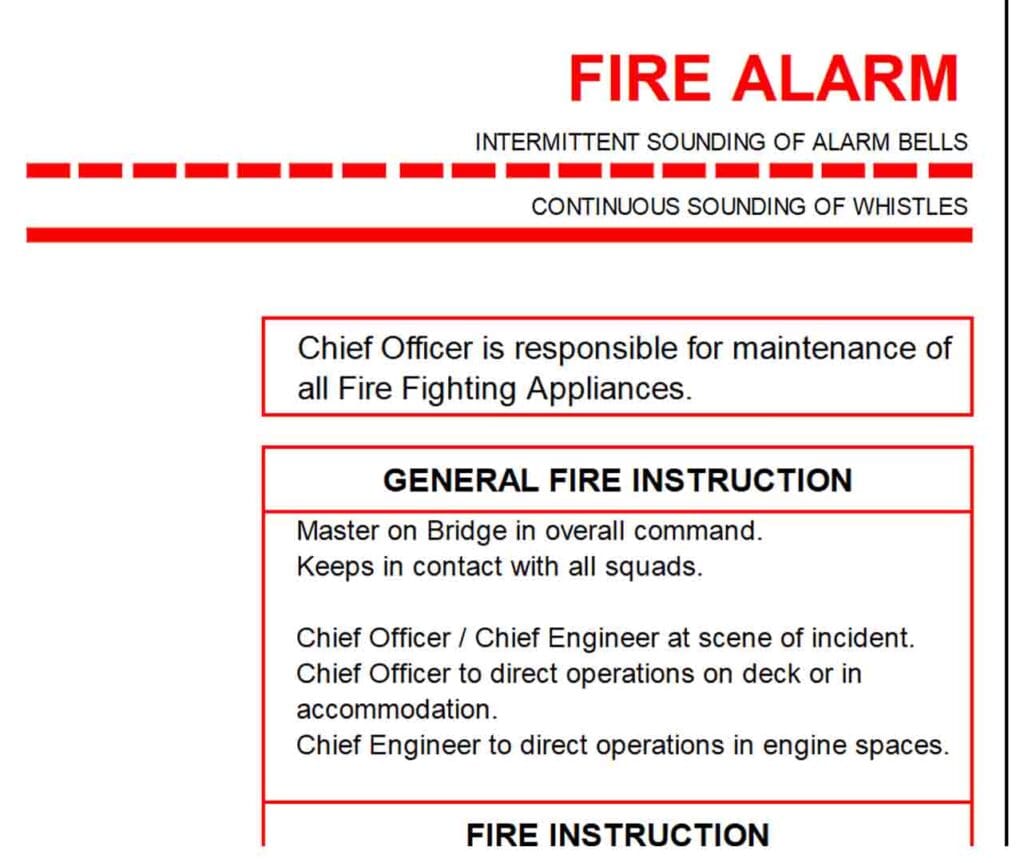
A fire alarm signal on board.
Sometimes, sensors could fail to detect the fire.
In such cases, crew members may manually sound the alarm or notify others by shouting warnings, as one of my crewmates did when a fire broke out in the ship’s swimming pool.
Surprisingly, the fire alarm only sounded after firefighting, and the situation was under control.
How to Recognize a Fire Alarm Signal
Fire alarms on ships are characterized by an intermittent ringing of alarm bells, accompanied by continuous whistle blasts.
On some vessels, you may hear the continuous sounding of the general alarm, followed by four prolonged blasts on the ship’s whistle.
These signals ensure that everyone, including those in high-noise areas, is alerted.
2. Abandon Ship Alarm
The abandon ship alarm is raised when staying on board becomes too dangerous, such as during an uncontrollable fire or if the vessel is sinking.
This alarm signals all crew members to proceed to their assigned lifeboat stations and prepare to evacuate the ship.
How to Recognize an Abandon Ship Alarm Signal
The abandon ship alarm typically consists of seven short blasts followed by one prolonged blast on the ship’s whistle.
On some vessels, this signal is accompanied by the continuous sounding of alarm bells.
False alarms can happen. Always wait for the captain’s verbal command over the public address system to officially order the abandonment of the vessel.
What to Bring During an Abandon Ship Alarm
Crew members must take essential survival gear, including lifejackets, immersion suits, extra food, water, blankets, and any other necessities for survival while awaiting rescue.
Consult your station bill to fully familiarize yourself with your duties.
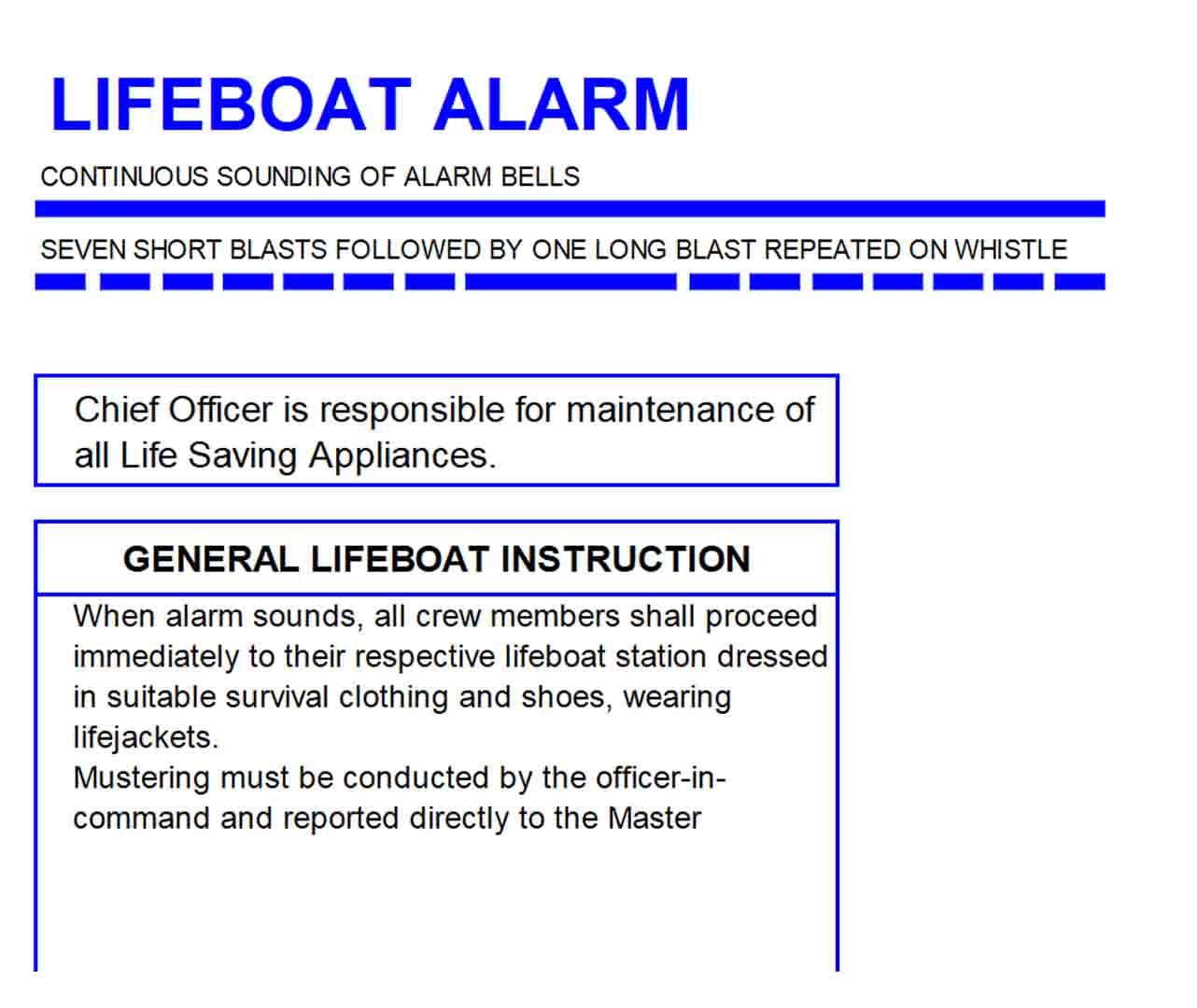
3. Man Overboard Alarm
The man overboard (MOB) alarm is a critical signal that indicates someone has fallen into the water.
This alarm is instantly recognizable because it follows the Morse code signal for the letter “Oscar” (O).
How to Recognize a Man Overboard Alarm Signal
The man overboard alarm consists of three prolonged blasts on the ship’s whistle, corresponding to the Morse signal “Oscar.”
This sound not only alerts the crew but also warns nearby vessels, signaling an emergency operation.
On some ships, the man overboard alarm may be the same as the general emergency alarm. Thus, it’s important to check your ship’s specific emergency plan.
When is the Man Overboard Alarm Raised?
The MOB alarm is a manual alarm, meaning it can only be triggered manually.
When a person falls in the water, whether at sea while the ship is underway, in port when she is at anchor, or on a jetty where she is berthed, the OOW must sound the man overboard alarm.
Rescue Procedures for a Man Overboard
To recover the person, the crew quickly assembles a rescue team, which deploys the rescue boat.
The rescue operation follows established MOB recovery procedures to safely retrieve the person from the water.

4. CO2 Release Alarm
The CO2 release alarm is a critical safety signal on ships, indicating the imminent release of carbon dioxide (CO2), a fixed fire-extinguishing agent.
CO2 is highly effective in extinguishing fires by displacing oxygen, but this also poses a serious risk to anyone present, as it can cause asphyxiation.
Why is the CO2 Release Alarm Important?
Before releasing CO2, the captain raises the CO2 alarm to alert the crew. The crew must seal all openings in the affected area to contain the gas.
A headcount is conducted to ensure no personnel are inside the protected space before releasing the CO2.
Only after confirming everyone’s safety can the captain or chief engineer activate the system.
How to Recognize a CO2 Release Alarm Signal
The CO2 release alarm stands out due to its distinct audio-visual warning system.
The audio signal is a continuous, high-pitched blast from the CO2 horn, specifically inside the protected area, such as the engine room.
To ensure visibility in noisy environments, this alarm is accompanied by high-intensity strobe lights.
These visual cues make the CO2 release alarm unmistakable, even in chaotic conditions.
5. Ship’s Security Alarm (SSAS)
The Ship’s Security Alarm System (SSAS) is designed to signal a security threat on board, such as piracy or armed attacks.
It’s a mandatory requirement under the SOLAS Convention as part of the International Ship and Port Facility Security (ISPS) Code.
When is the Ship’s Security Alarm Activated?
The SSAS is commonly used in high-risk areas like Somalia, the Gulf of Aden, and West Africa, where piracy attacks are more frequent.
When triggered, the SSAS does not activate any audio-visual alarms on the vessel itself.
Instead, it silently sends a distress signal to the shipowner’s office onshore and the vessel’s flag state.
These authorities then contact local security forces to respond to the threat.
How is the SSAS Operated?
The SSAS activation points are discreetly installed and only known by the Master and the Ship Security Officer (SSO).
This ensures that the system remains hidden and secure in the event of an attack.
When the shipowner receives the alarm, they verify its authenticity through coded communications with the vessel to determine if the signal is genuine or a false alarm.
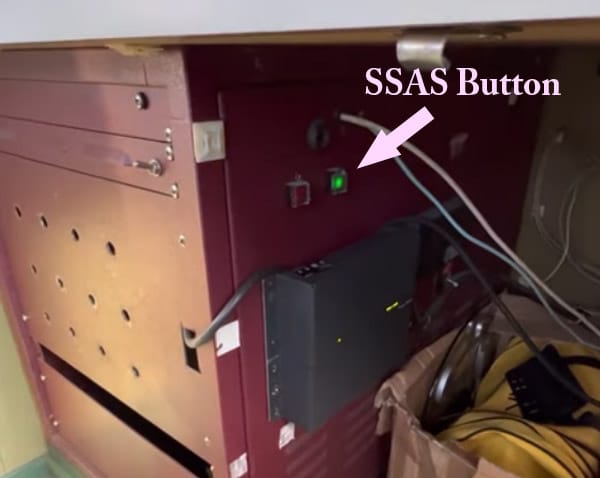
6. General Alarm
The general alarm is an emergency signal used to notify the crew of a broad range of emergencies on board.
It consists of seven short blasts followed by one prolonged blast on the ship’s alarm bells and whistle.
This signal is activated when there’s an crisis that doesn’t have a specific alarm assigned, such as the ones listed below.
Situations Where the General Alarm is Used:
- Oil spill
- Emergency steering failure
- Toxic gas release
- Helicopter emergency
- Grounding/stranding
- Collision
- Flooding
- Excessive list
- Serious illness, injury, or death
Because it would be overwhelming to memorize a distinct alarm for every possible danger, many ships rely on the general emergency alarm to simplify responses and avoid confusion.
How the General Alarm Works
The general alarm signal consists of the same pattern on both the ship’s whistle and bell—seven short blasts followed by one prolonged blast.
This ensures that the alarm is delivered successfully, even if one of the systems fails.
After the alarm sounds, the captain uses the public address (PA) system to announce the specific nature of the situation.
The general alarm should be rung continuously without attendance, which wasn’t the case for the ferry Sally Star when she caught fire in the engine room.
Important Note:
The signal for a fire alarm and a general emergency alarm, or any other alarm can be identical.
The key difference lies in the captain’s announcement over the PA system, which clarifies the type of crisis.
ALWAYS listen carefully to the PA announcement after hearing the general alarm signal to understand the specific situation.
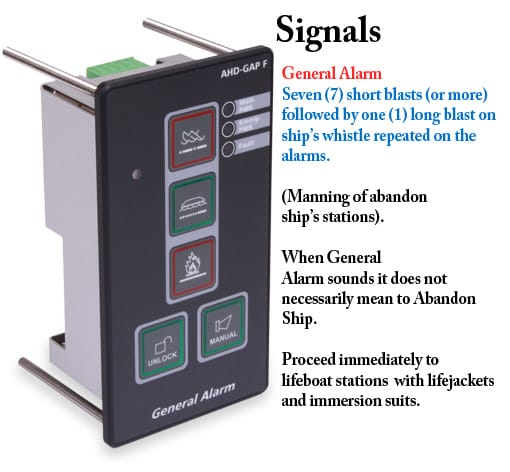
Why is it important to know these alarms?
Knowing emergency alarms on board is crucial for every seafarer, as ships are always at risk of encountering emergencies.
While these signals may vary from one vessel or company to another, it’s your responsibility to memorize and understand them in order to respond quickly and accurately.
Training and Familiarization
Emergency preparedness is a key part of seafarer training.
We undergo extensive drills, monthly onboard familiarizations, and computer-based training to ensure we’re ready for any situation.
Authorities such as vetting inspectors, port state control officers, and coast guards may also test your knowledge of these alarms.
Failing to respond correctly to these inspections can have serious consequences.
Enhancing Focus and Confidence
But beyond regulatory compliance, the most important reason to know these alarms is to build focus and confidence.
When you’re familiar with each signal, you can immediately recognize the type of situation and respond without hesitation.
In summary, being well-versed in the ship’s emergency alarms doesn’t just ensure compliance with safety regulations.
It equips you with the confidence to make the right decisions in times of crisis.
What if you ignore the emergency alarms?
Two words: Big mistake!
Alarms are there to warn us that our ships and the lives in her are in grave danger. Ignoring them means suicide.
You can choose to ignore them, but what about your crewmates?
If one of the 25 crew members refuses to answer the call for an emergency, the other 24 will assume that you are injured (or dead) and start a search and rescue within the ship.
These steps divert valuable resources and time that could be spent addressing the actual danger.
If the crew saves the ship and mitigates the emergency, your retardation will not have any place on board.
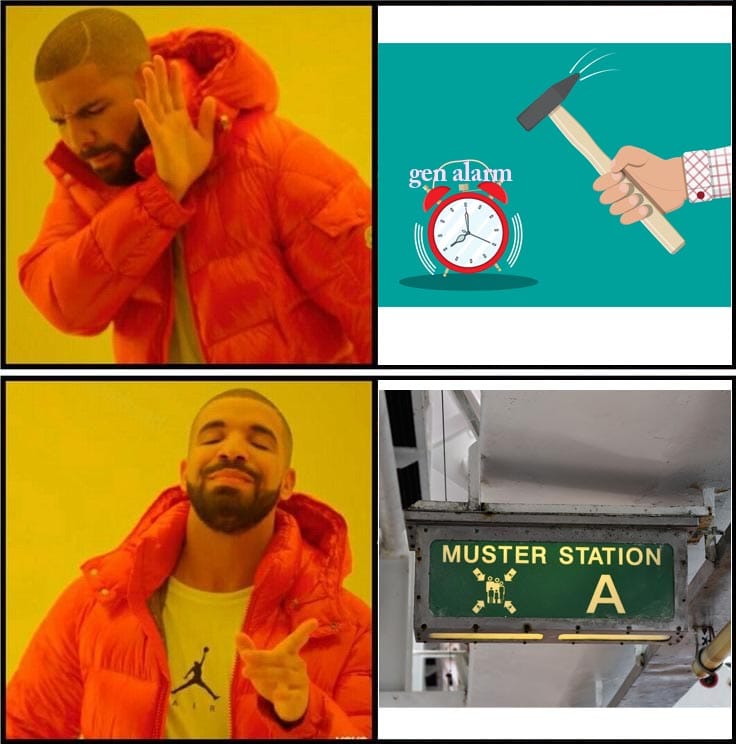
Tips on how to easily memorize these emergency alarm signals
Memorizing ship emergency alarm signals can feel overwhelming, but with the right strategies, it becomes manageable.
Here are some practical tips to help you quickly recall these alarms:
Pay Attention During Drills
The best way to memorize these signals is to focus during safety drills. Repetition during drills will help cement the sounds and patterns in your memory.
Use Semantics for Quick Recall
Associating each signal with something familiar can make memorization easier.
Here are a few tricks:
- Man Overboard Alarm: The signal is the Morse Code for the letter “Oscar” (— — —), which represents three long dashes.
- Distress Signal (SOS): The distress signal is SOS (• • • — — — • • •). You can link this to the Nokia SMS ringtone, which is almost the same as SOS, just missing one dash. The sound is (• • • — — • • •).
You can listen to it here.
Memorize Fire Alarm Signals
Fire alarms are intermittent, meaning they sound in rapid, continuous succession.
A trick is to break the word “in-ter-mit-tent” into syllables, which mimics the pattern of the alarm’s on-off nature.
General Alarms and Abandon Ship Alarms
Both alarms follow the same pattern (seven short blasts followed by one prolonged blast).
The difference comes with the public address (PA) announcement that follows.
If you’re nervous and lose track of counting the short blasts, look for the prolonged blast. This often signals a general emergency alarm.
CO2 Alarms
CO2 alarms are distinct because they use both audio and visual signals.
The sound is continuous and very high-pitched, mostly found in engine rooms, pump rooms, and sample rooms.
Ship Security Alarm (SSAS)
Don’t worry too much about memorizing the SSAS. Since it’s a silent alarm, only the master and ship security officer know when it’s activated.
You won’t need to respond to this one.
Lastly, always check your emergency plan since companies use different alarm signals.
Final thoughts
Imagine if alarms were not invented.
Many ships and crew members on board would die without putting up a fight against real emergencies. They would not know what hit them!
We should be thankful that these alarms function even if it’s the dead of the night. And we should be more grateful not to use them in the first place.
May the winds be in your favor.


Leave a Reply